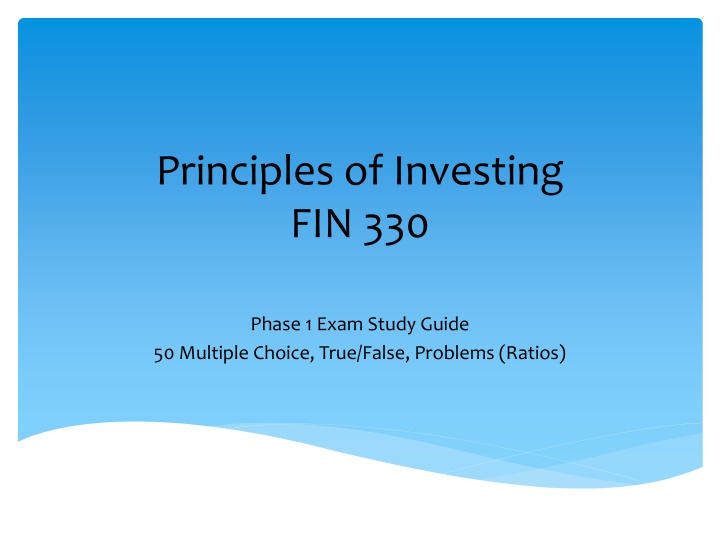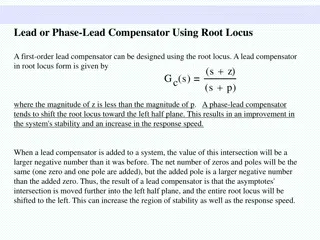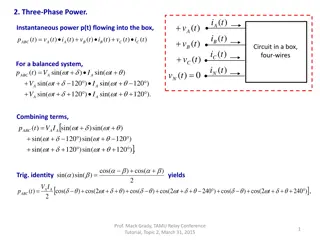
Principles of Investing: Exam Study Guide for FIN 330 Phase 1
Explore chapters on economic activity, industry analysis, valuation of firms, and financial statement analysis in this comprehensive study guide for FIN 330 Phase 1 exam. Learn about the influence of Federal Reserve policy, industry life cycles, stock valuation models, and measures for financial analysis.
Download Presentation

Please find below an Image/Link to download the presentation.
The content on the website is provided AS IS for your information and personal use only. It may not be sold, licensed, or shared on other websites without obtaining consent from the author. If you encounter any issues during the download, it is possible that the publisher has removed the file from their server.
You are allowed to download the files provided on this website for personal or commercial use, subject to the condition that they are used lawfully. All files are the property of their respective owners.
The content on the website is provided AS IS for your information and personal use only. It may not be sold, licensed, or shared on other websites without obtaining consent from the author.
E N D
Presentation Transcript
Principles of Investing FIN 330 Phase 1 Exam Study Guide 50 Multiple Choice, True/False, Problems (Ratios)
Chapter 5: Economic Activity Company analysis is conducted in a Top to Down manner: from the macro to micro. Chief among the macro factors is Federal Reserve Policy (Monetary). Fed Policy tends to manage the impact of economic and business cycles; Especially as they impact employment and personal income. A. How does Federal Reserve [Monetary] Policy influence company behavior? (think interest rates & credit supply) B. Why do stock prices tend to lead business cycles? C. How do economic indicators work? Leading, Coincident, Lagging D. Why do investors look at the Fed s Beige Book?
Chapter 6: Industry Analysis Stock prices are influenced by industry effects. Industries undergo life cycles very similar to product life cycles. Sensitivity to where an industry is going, relative to their life cycles, can be important in establishing a range of values. A. How does the industry life cycle resemble the product life cycle? B. How does competition affect an industry? 1. Does the domestic industry have much foreign competition? 2. Impact of number of domestic competitors C. How do we classify industries? Why?
Chapter 7: Valuation of the Firm The basic process for valuation of any business is to look at its revenue stream (sales) and how well it converts sales into profits. There are several competing models for valuing stock. A. Gordon Growth Model (Normal): Stock price = Dividend to be received divided by (cost of equity capital minus the growth rate in dividends) Price = D1/ (Ke g) B. P/E Model: Attractiveness of firms reflected earnings multiple that investors are willing to pay for a share of stock. Higher P/E means more attractive. Lower is less attractive. C. Capital Asset Pricing Model: stock returns are a function of risk premiums and beta ( ). The expected return [E(Ri)] equals expected return on the risk free asset plus beta times the risk premium: E(Ri) = E(Rf) + [E(Rm) E(Rf)]. E(Ri) the is used the same way as Kein the Gordon Growth Model. D. The Sustainable Growth rate is also of interest to analysts: SGR = ROE * Retention Ratio (How much of the firm s profit is reinvested in the business.)
Chapter 8: Financial Statement Analysis The objective of financial statement analysis (FSA) is to direct managerial attention to areas of concern in corporate financial performance. A. What are some measures we can use to gauge or measure managerial efficiency in the following areas? 1. Liquidity management? (Current & Quick Ratios) 2. Asset management? (Days Sales Outstanding, Inventory Turnover) 3. Debt management and strategy? (Leverage and ROE) 4. Profitability? (Cost controls; variable, fixed) B. What is the primary objective of the DuPont system of financial analysis? C. How does debt impact DuPont analysis? D. What types of information are contained in the balance sheet? (LHS versus RHS) E. What information is contained in the income statement? F. What information is contained in the statement of cash flows?
Chapter 9: Efficient Markets The Efficient Market Theory suggests that process reflect all known information (Historical, Current, and Inside). A. What is the Efficient Markets Hypothesis? B. The Principal Implication of EMH? C. What are the Three Forms of Efficiency? D. How do we define Abnormal Returns? E. How does Fundamental Analysis help market efficiency?
Chapter 10: Behavioral Finance Technical Analysis The relatively new field of Behavioral Finance seeks to explain why markets are not efficient. It explores the impact of how individuals make decisions and the impact on security prices. A. Arguments for Behavioral Finance 1. The role for cognitive psychology (how we make decisions) 2. How investors approach problem solving (heuristics) a. Representativeness (judgements about probability of an event) b. Hindsight bias (explanations for what happened yesterday) c. Self-attribution (take credit for good outcomes, blame others for bad outcomes)
Chapter 10: Behavioral Finance Technical Analysis Technical Analysis seeks to profit from the herd behavior of market players. It dismisses the usefulness of fundamental analysis and instead looks for repeating patterns in the market. A. What is momentum? B. What do the following terms indicate to technical traders: 1. Support level 2. Resistance level C. What does it mean to be a contrarian ? D. What is a self-fulfilling prophecy?






















